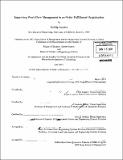| dc.contributor.advisor | Chris Caplice, Andreas Schulz and Roy E. Welsch. | en_US |
| dc.contributor.author | Sandhu, Kuldip (Kuldip Kaur) | en_US |
| dc.contributor.other | Leaders for Global Operations Program. | en_US |
| dc.date.accessioned | 2011-09-27T18:37:11Z | |
| dc.date.available | 2011-09-27T18:37:11Z | |
| dc.date.copyright | 2011 | en_US |
| dc.date.issued | 2011 | en_US |
| dc.identifier.uri | http://hdl.handle.net/1721.1/66052 | |
| dc.description | Thesis (M.B.A.)--Massachusetts Institute of Technology, Sloan School of Management; and, (S.M.)--Massachusetts Institute of Technology, Engineering Systems Division; in conjunction with the Leaders for Global Operations Program at MIT, 2011. | en_US |
| dc.description | Cataloged from PDF version of thesis. | en_US |
| dc.description | Includes bibliographical references (p. 75-76). | en_US |
| dc.description.abstract | Amazon.com is experiencing dramatic growth in customer demand through increasingly diversified product offerings and from introduction of Amazon Prime Shipping. As the volume of customer orders increases and a higher number of orders placed are single unit orders, labor and work management at the fulfillment centers must be improved to increase the throughput while fulfilling orders on time. Managing outbound work flow and labor at Amazon fulfillment centers is a complicated process that is controlled manually through limited tools, but has large implications on operational performance and customer experience. The six month LGO project focused on improving the outbound flow management process at the RNOI Fulfillment Center located in Fernley, Nevada. This thesis analyzes the current workflow management process, identifies major concerns with this process, and outlines the solutions implemented to improve flow 'management. The project was approached using lean principles and methodologies, especially when identifying and implementing solutions. Specifically, the concepts of Genchi Gembutsu, PDCA (Plan/Do/Check/Action) and effective change management were used heavily. The major changes implemented were flow management structure change, standardized training and tools to make flow decisions, optimal local settings for work in progress, inclusion of charge forecast into labor planning and hourly tracking of shift performance. The results demonstrated an annual cost savings of $353,000 at RNOI. The concepts described in this thesis extend beyond a fulfillment center setting to planning labor in manufacturing, service operations like customer service centers and healthcare facilities. | en_US |
| dc.description.statementofresponsibility | by Kuldip Sandhu. | en_US |
| dc.format.extent | 76 p. | en_US |
| dc.language.iso | eng | en_US |
| dc.publisher | Massachusetts Institute of Technology | en_US |
| dc.rights | M.I.T. theses are protected by
copyright. They may be viewed from this source for any purpose, but
reproduction or distribution in any format is prohibited without written
permission. See provided URL for inquiries about permission. | en_US |
| dc.rights.uri | http://dspace.mit.edu/handle/1721.1/7582 | en_US |
| dc.subject | Sloan School of Management. | en_US |
| dc.subject | Engineering Systems Division. | en_US |
| dc.subject | Leaders for Global Operations Program. | en_US |
| dc.title | Improving work flow management in an order fulfillment organization | en_US |
| dc.type | Thesis | en_US |
| dc.description.degree | S.M. | en_US |
| dc.description.degree | M.B.A. | en_US |
| dc.contributor.department | Leaders for Global Operations Program at MIT | en_US |
| dc.contributor.department | Massachusetts Institute of Technology. Engineering Systems Division | |
| dc.contributor.department | Sloan School of Management | |
| dc.identifier.oclc | 752310408 | en_US |
